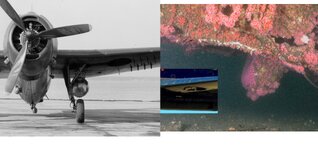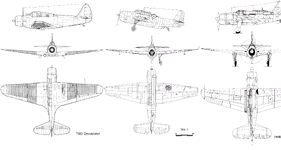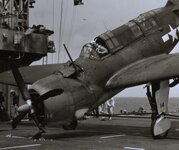Hi,
I'm an avid wreck diver in Southern California (see Wrecked in my rEvo).
We located a new airplane wreck site last week and we are going through the process of identifying it. Step 1 is usually figuring out the type of airplane and step 2 is identifying the specific plane. In this case, I don't think we're going to be able to find a bureau number given the state of the wreck site.
We think we know what type of plane it is, but I wanted to get some additional thoughts from the experts on this forum. I don't want to bias anybody's opinion so I won't post what type of plane we think it is.
Key characteristics (with photos below) are: 14 cylinder radial engine, two oil coolers, 50 cal (I think) gun in the wing. In addition, we think it is a carrier based airplane due to a crack in the port wing that looks like where the wing would fold. I also included a picture of the wheel which is sticking down from the port side wing.
Pictures are below. I have more if anybody needs additional photos but the entire back of the fuselage behind the pilot's seat is gone (we think it might be nearby).
Thanks,
Brett Eldridge







I'm an avid wreck diver in Southern California (see Wrecked in my rEvo).
We located a new airplane wreck site last week and we are going through the process of identifying it. Step 1 is usually figuring out the type of airplane and step 2 is identifying the specific plane. In this case, I don't think we're going to be able to find a bureau number given the state of the wreck site.
We think we know what type of plane it is, but I wanted to get some additional thoughts from the experts on this forum. I don't want to bias anybody's opinion so I won't post what type of plane we think it is.
Key characteristics (with photos below) are: 14 cylinder radial engine, two oil coolers, 50 cal (I think) gun in the wing. In addition, we think it is a carrier based airplane due to a crack in the port wing that looks like where the wing would fold. I also included a picture of the wheel which is sticking down from the port side wing.
Pictures are below. I have more if anybody needs additional photos but the entire back of the fuselage behind the pilot's seat is gone (we think it might be nearby).
Thanks,
Brett Eldridge



